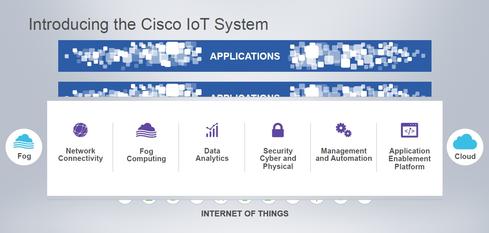Cisco Unveils IoT Framework
Networking giant expands its IoT portfolio with 15 new products for network connectivity, IoT security and manageability.
June 29, 2015

Cisco has been pushing what it called the "Internet of Everything" for a number of years, and on Monday expanded on its IoT strategy with the launch of the Cisco IoT system, including 15 new products. The framework is designed to streamline Internet of Things deployments.
"Despite the hype around IoT, it really is happening," Kip Compton, VP of Cisco's IoT systems and software group, said in a media briefing that was noticeably devoid of the Cisco-coined Internet of Everything term.
A survey of Cisco customers showed that 95% plan to deploy IoT within three years. But they face several challenges, including heterogeneous devices, security, and scalability, Compton said.
Cisco's IoT framework is designed to overcome those issues by focusing on six "pillars" for successful IoT deployment: network connectivity, security, fog computing, data analytics, management and automation, and an application enablement platform.
The 15 new products include an addition to Cisco's industrial Ethernet switch line, a new wireless access point for mass transit and municipal systems, and two new industrial routers with WiFi and 4G/LTE connectivity. On the security front, Cisco introduced two new IP surveillance cameras, and added its TrustSec technology to its industrial switch and router line.
Figure 1: 
Cisco also launched IoT Field Network Director management software designed for industrial scale, and Fog Director, which enables central management of applications running at the edge.
At the media briefing, Cisco customer Del Papa Distributing, a beer distributor based in Texas, talked about how the company worked with Cisco partner Zones to build a new distribution facility that leveraged IoT technology to improve security and shipping operations. Zones built a unified wired and wireless network that connected previously unconnected things and included video surveillance and physical access controls.
Inventory temperature monitoring on the plant floor and physical security were key aspects of the deployment -- obviously, you don’t want to overheat beer plus it needs to be protected. Overall, the system has enabled Del Papa to reduce its energy consumption and increase productivity, Steve Holtsclaw, VP of IT at the distributor, said. "Customers are getting their beer faster."
Also in the briefing, Brian McGlynn, president of Davra Networks -- another Cisco partner -- talked about how Davra helped the San Diego Metropolitan Transit System improve the real-time information it provides riders using Cisco fog computing technology.
The transit system, which provides, bus and light rail services, had deployed 150 information signs across San Diegostreets and buildings, but actually turned off the signs because it wasn't able to provide accurate information, McGlynn said. Davra addressed the problem by combining Cisco gateways with its IoT AEP platform to provide riders with accurate information about train arrivals.
About the Author
You May Also Like




